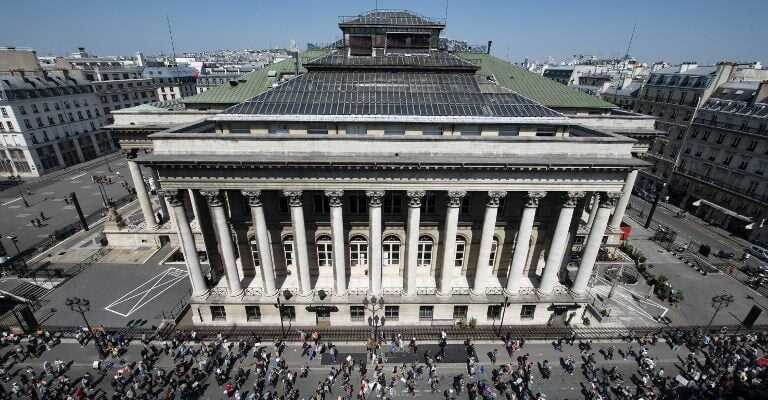(BFM Bourse) – The CAC 40 is accelerating its fall which began on Friday (-1.75%) with a plunge of 3.97% which brings it back below 6800 points on Monday. Global markets are faltering on fears that geopolitical tensions will escalate into armed conflict in Ukraine and on the eve of another Fed meeting that is sparking a sharp resurgence in risk aversion.
The atmosphere, already fearful and bearish in the morning (-1.90% at 12 p.m.), gradually gave way to panic before turning into capitulation on Monday afternoon on the Parisian market. Weighed down by the new bright red opening of Wall Street where all the indices are now in the correction zone, the CAC 40 increased its losses and ended the session with a fall of 3.97% to 6,787.79 points, a low since last December 3. The barometer thus signs in quick succession its two worst daily performances of 2022, which had already suffered a decline of 1.75% on Friday in the face of operators’ fears about the evolution of the Fed’s monetary policy. The trading volume was particularly high on Wednesday, with more than 6 billion euros traded on CAC 40 stocks.
The fact that the armed forces of NATO countries are on alert, while Western countries are worried about a possible Russian military intervention in Ukraine in the coming days or weeks, heightens the concern of investors, who prefer to shed risky assets such as stocks.
The escalation of tensions in Ukraine worries the markets
The session “is dominated by a feeling of risk aversion caused by a multiplicity of factors, including the bearish context on the equity markets in the run-up to the Fed meeting on Wednesday, the geopolitical tensions in Ukraine or the election Italian presidential candidate whose nomination process begins on Monday”, summarizes Guillaume Dejean, analyst at Western Union Business Solutions. The news is indeed focused on the risk of military conflict in Ukraine, while the Secretary-General of NATO has indicated that the member countries of the Atlantic alliance are placing their armed forces on alert and will send reinforcements in Eastern Europe.
“NATO will continue to take all necessary measures to protect and defend all its allies, including by strengthening the eastern part of the Alliance”, indicated Jens Stoltenberg, when Ukraine and Western countries fear a possible intervention by Russia, which last week demanded the departure of NATO forces based in Romania and Bulgaria. The United States and Great Britain are recalling the staff of their embassies in Ukraine, and invite their nationals to leave the country in the face of the risk of conflict.
There is also tension between the United Arab Emirates and Yemen, the Emirates having intercepted two ballistic missiles targeting the capital Abu Dhabi, incriminating the Yemeni Houthi rebels. This is the first time the UAE has reported an attack inside its borders. These tensions kept oil prices at a high level, before the latter in turn fell victim to operators’ risk aversion, which extended to all asset classes this afternoon. Shortly after 5:40 p.m., a barrel of Brent is trading at 84.6 dollars, down 2.4% from Friday’s close. On the foreign exchange market, operators took refuge in the greenback, leading to a further decline of 0.30% in the euro to 1.1313 dollars.
At the same time, among the most speculative assets, bitcoin fell nearly 6% to $34,300, now accumulating more than 50% in losses since its all-time high dating back only to November 2021.
Currency hardening
The escalation of geopolitical risks in recent days comes at a time when the markets are looking with some tension to the meeting of the Fed’s monetary policy committee, which could confirm the scenario of a first monetary tightening as early as March. . “We expect a strong rhetoric on future monetary policy tightening to counter inflationary threats, but no concrete announcement aside from confirmation of an initial rate hike in March. the FOMC meeting should be to buy time, and therefore visibility for its economic forecasts, in order to regain credibility,” said Franck Dixmier, global head of bond management at AllianzGI.
DJIA and S&P join Nasdaq in correction territory
Already down 2.7% on Friday, the Nasdaq Composite suffered an additional drop of more than 3% on Monday at 5.30 p.m. geopolitical tensions around Ukraine. At the same time, the DJIA and the S&P 500 dropped 2% and 2.6% respectively, bringing both of them down more than 10% from their peak.
Within the flagship tricolor index, only one defensive value floats: Orange, with a gain of 0.9%. For the rest, the list is exclusively composed of red, with a plunge reaching 8.6% at the close for Saint Gobain in reaction to the British government’s threat to ban access to the United Kingdom to all companies that are marketing combustible cladding and insulation after the Grenfell Tower fire. While Renault is preparing to unveil a massive investment plan in electricity with its Japanese partners Nissan and Mitsubishi, which would allow it to evolve in the green at midday, the manufacturer is not ultimately spared. (-2.8%). Stellantis ebbs for its part by 7.4%.
The decline affects all sectors without any real discrimination, both tech (-7.3% for Wordline), heavy industry (-6.4% for ArcelorMittal) or aeronautics (-6.4%) and banking (- 5.6% for Societe Generale) or luxury (-4.9% for LVMH).
Within the SBF 120, the title of the operator of retirement homes Orpea collapsed by 16.1% when the group requested its suspension of quotation, a few days before the publication, at Fayard, of a work entitled “The gravediggers” promising “revelations about the system that mistreats our elders”. In its wake, the other sector specialist Korian also collapses (-14%), even though he is not the subject of any charges.
Quentin Soubranne – ©2022 BFM Bourse
